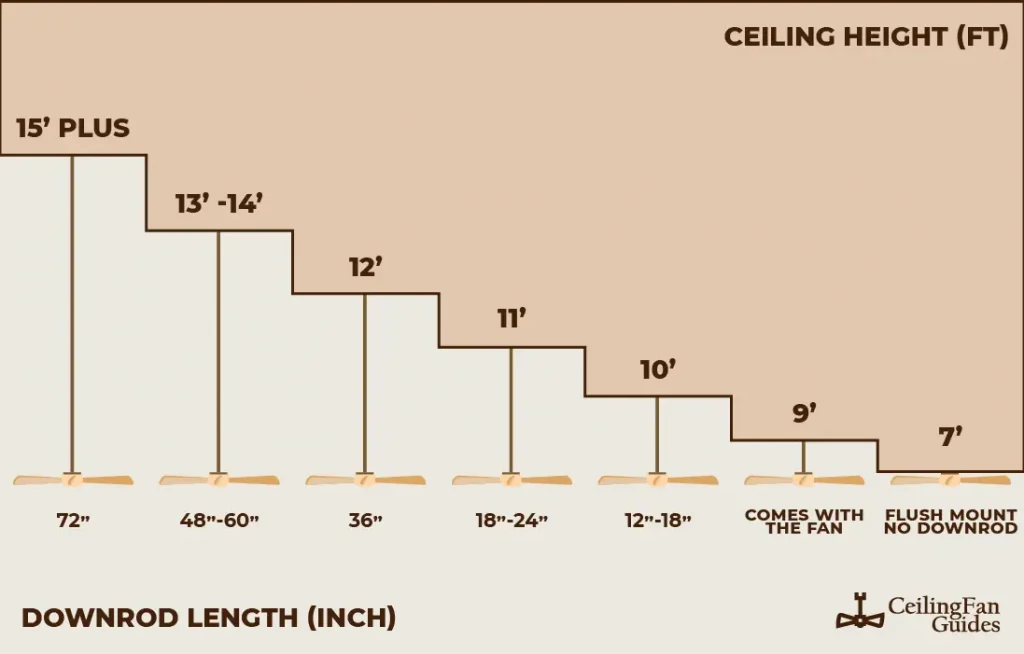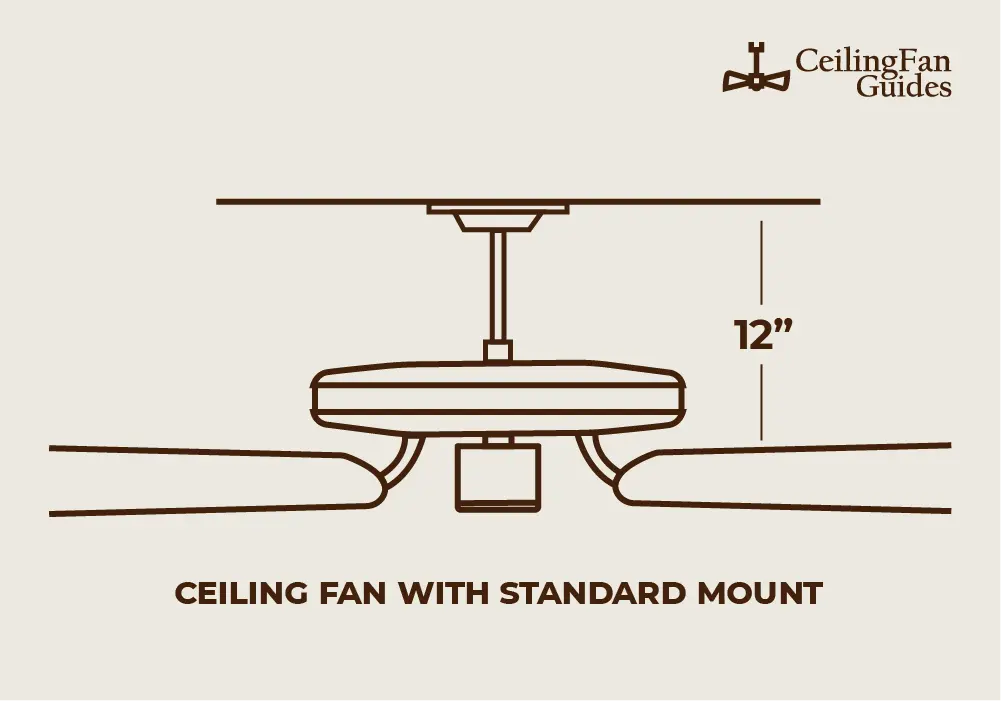Ceiling fans are often installed in rooms where there is no electrical outlet near the ceiling. The alternative then would be to use a down rod for the ceiling fan.
Choosing the right downrod length for your ceiling fan is quite important. If you select the wrong one, it won’t bring the most output of cooling to make your room cool as soon as possible.
Considering the style, size and everything else is not enough to get a ceiling fan. You also need to buy one that matches your room. For example, if you have a high ceiling then you should surely buy a fan with a longer downrod.
This guide will help you understand which things should you know regarding the downrod of the ceiling fan and how to select the fan with the perfect length for it.
What is a Downrod?
A downrod is a long rod that connects the ceiling fan to the ceiling. It’s usually made of metal. It is used to adjust the distance between the fan blades and the ceiling. It has threads on each end: one end that fits into a threaded hole in your ceiling box and another that screws onto the bottom of your fan.
The length of the downrod can vary depending on how close or far away you want to place your blades from your ceiling. For example, if you prefer low ceilings, then using a longer downrod would allow you to raise up your blades from their lowest position without having them scrape against any obstructions such as beams or pipes.
You can change out an existing downrod for another length by simply unscrewing one end from its current position and screwing it onto a new location at either side of where it was previously connected (which may require some additional nuts).
Are ceiling fan downrods universal?
Ceiling fan downrods are not universal, but they are specific to the fan’s model and manufacturer.
Downrod-supported ceiling fans have different models, and they use different mounting systems based on their compatibilities, such as the diameter of the downrod and the size of the room. Apart from this, compatibility is also dependent on the color options, UL rating, and installation method.
Some downrod-supported fans have a “ball-and-socket” mounting system. This system allows for different kinds of adjustments. The other fans, on the other hand, have a “fixed mounting bracket” that restricts them to a single type and size of downrod.
To ensure that your ceiling fan is compatible with the right downrod type, check its brand and model number, and purchase a downrod that is fully compatible with the fan you have.
If you are unsure about the model, check out the user manual that came along with your fan. If you don’t have a user manual, you can contact the manufacturer to learn about the model of your fan as well as the compatible downrod type.
Also, make sure that the downrod has the length that you need based on how high your ceiling is.
What Can Go Wrong If You Use An Incompatible Downrod?
Using an incompatible downrod can make your ceiling fan wobble, reduce the airflow, and even cause structural damage to the fan or the ceiling. More problems include:
To avoid these common issues and ensure proper installation and safety, it is always better to match the model of your fan and look for a compatible downrod that is supported by your fan’s model.
How to calculate the length of the ceiling fan’s downrod?
There are two ways to find out the length of the downrod you need for your ceiling fan:
Measure from the ceiling to the floor
f you have a light fixture and want to install a ceiling fan with light, it’s important to measure from the ceiling to where you want your fixture positioned. This is because some fan manufacturers provide different lengths for lights versus non-lights (and some don’t provide any).
You’ll also want an accurate measurement so that there’s enough room between your ceiling and the bottom of the light fixture, so be sure not to miss this step!
Measure from the top of the ceiling fan mounting bracket down towards the bottom of the blades
Again, when planning out this measurement keep in mind whether or not there will be a light fixture attached at all times when using this method rather than other methods mentioned above just listed here as well.
Especially if installing these two items together on top of each other within one room or area without access underneath whatsoever.
Then try measuring only halfway up from bottom blade tip instead which should give fairly accurate results too.
Length of the Downrod vs the height of your room

One of the most important factors to consider when choosing a length of the downrod is how high your ceiling is. If your ceiling is low than the average height, you will need a shorter downrod. The standard height for a ceiling fan is about 7 feet 6 inches off the floor, but there are many options for people with higher ceilings.
For example, if you want to install a 52-inch fan in your home which has 8-foot ceilings then you would need a 10-foot downrod or longer depending on how much space between the top of the blade and the bottom of the light fixture.
Another thing that can affect where exactly it should be placed in relation to floor level is how much space does it require between itself and the floor? A good rule of thumb here would be about 2 feet away from the bottom edge (you can also measure this distance yourself).
This measurement depends on the type/model installed as well as personal preference – some models have built-in chains which allow users to adjust the height accordingly; others require additional hardware set up outside before being able to hang them properly (which may take additional time).
Choosing the correct length of the downrod

When choosing the correct length, you should make sure that it’s long enough for the fan to clear the floor and be out of reach of children.
Additionally, it’s important to choose a downrod that’s not too long that it hits the head of your tallest person in the room, or so short that your ceiling will scrape your new fan.
Make a wise decision!
Downrods come in a variety of sizes and thicknesses. To make sure you choose the right length, you’ll want to be aware of two things:
Choose a size that’s appropriate for your room
The best advice is to measure the dimensions of your space before shopping for fans online or in stores. This will help ensure that your new fan fits perfectly in its designated area without taking up too much room or being too small for its surroundings.
Make sure the blades reach at least 7 feet above the floor—and preferably 9 feet high—to keep them out of reach when children are in play mode (or sleep mode!).
Choose a Right Style That Matches Your Room
Select a style that matches other décor pieces already present in each room where you plan on installing them; this ensures continuity throughout each environment rather than clashing with existing furniture styles and colors!
Looking To Buy A Ceiling Fan? Read Our Guide:
Which ceiling fan is best for high ceilings?
If you’re wondering what the best ceiling fan for your home is, consider these two quick options:
Ceiling Fans with Downrod’s
Ceiling fans with downrods are ideal for rooms with high ceilings. They’re also useful for making your home appear larger. If your home has a high ceiling, fans that support downrod mounts can be easily adjusted.
You can also install a short or long mount to adjust the height of your fan based on the ceiling heights.
Remote-Controlled Ceiling Fans
These fans allow you to control your fan from anywhere in the house or outside through a smartphone app or remote control.
If you have pets and want them to stay away from how much air is being circulated, remote-controlled fans can help keep them safe while still allowing plenty of circulation.
FAQs – Get one step closer to a reliable decision!
How far should a fan hang from the ceiling?
The height at which your ceiling fan will hang from the ceiling. If it’s too low or too high, it could cause people to bump into it or interfere with the airflow from your fan. So make sure you are measuring the size of your room and take all measurements before installing a downrod fan.
How high should a ceiling fan be?
To ensure proper cooling, you need to install your ceiling fans at least 7 feet above the ground, centered in the middle of the room, with no walls or other obstructions between the floor and the top of your ceiling fans.
How long should a downrod be for a 20-foot ceiling?
For ceilings between 9 and 20 feet high, downrods are available from 6” to 120”. These are the most popular lengths for these ceiling heights.
Conclusion
So, you need to consider all the above aspects to choose a right downrod for your fan. If you are not very much concerned about the style and type of ceiling fan then it is better to choose a length of 3-4 feet so that the people in a room feel the breeze from the fan and say wow just by seeing it.
However, if you are very particular about the look and feel of your ceiling fan then go for any of the other options.

